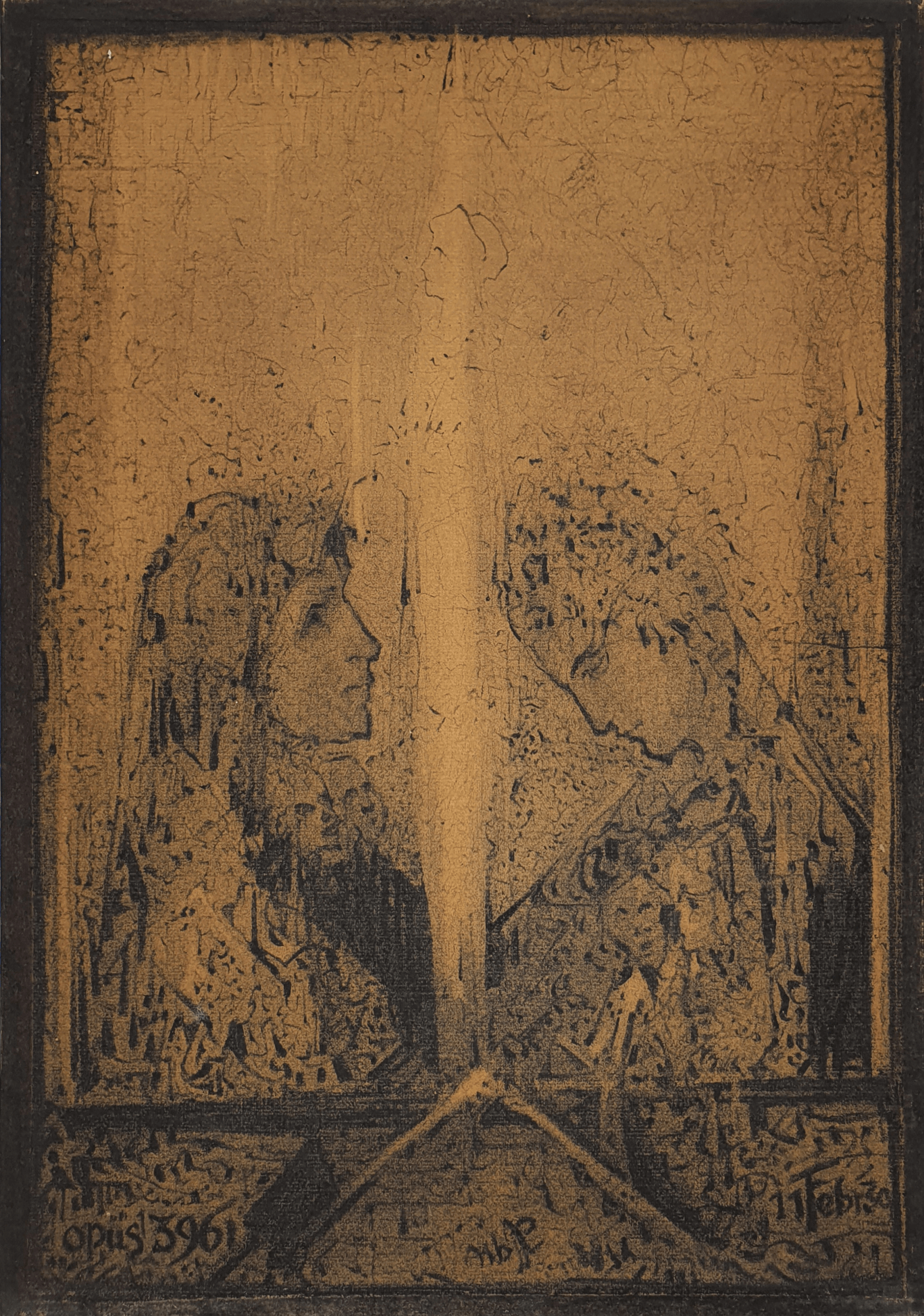Opus 3961
A.A. (Albert) Plasschaert

[EN]
The work, Opus 3961, was made on 11 February 1930 in Albert Plasschaert's idiosyncratic style. He used strong contour lines for the main figures, and created texture with nervous lines and markings.
In the main image, two women viewed in profile can be seen. The woman on the left looks up, possibly at the line drawing of a woman's head hovering above their heads. On the right, the woman has her eyes closed and head tilted down, apparently in contemplation.
On the lower margin he created a visual predella where he titled, signed and dated the work.
[NL]
Dit werk, Opus 3961, werd gemaakt op 11 februari 1930, in de stijl die kenmerkend is voor Albert Plasschaert. Hij gebruikte sterke contourlijnen voor de hoofdfiguren. Hij gaf het beeld textuur met een netwerk aan nerveuze lijnen en markeringen.
In de hoofdafbeelding zijn twee vrouwengezichten in profiel te zien. De vrouw links kijkt omhoog, mogelijk naar de lijntekening van een vrouwenhoofd dat boven hun hoofden zweeft. De rechtervrouw heeft haar ogen gesloten en het hoofd omlaag gekanteld – ogenschijnlijk in gedachten verzonken.
Aan de onderzijde maakte Plasschaert een visuele predella, waar hij het werk betitelde, signeerde en dateerde.
[EN]
Albert August Plasschaert (1866-1941) was the cousin of the art critic of the same name. As an artist he was an autodidact, he trained as an engineer originally. His work contains many mystical and religious references, as he was himself influenced by far-east inspired religious movements that gained popularity in The Netherlands. For Plasschaert, that influence resulted in a deeply personal, mystical-religious philosophy.
His work from the mid-1910s was among the first fully abstract art in The Netherlands, before the artists of De Stijl would work fully abstract. Much of his work is titled with philosophical titles, and all of his work has an 'opus'-number - opus meaning work.
Although Plasschaert was soon near-forgotten after he died in 1941, but since the last part of the 20th century, his work is consistently considered part of the symbolist avant-garde.
[NL]
Albert August Plasschaert (1866-1941) was de neef van de gelijknamige kunstcriticus. Hij was als ingenieur opgeleid, en was autodidact als kunstenaar. Zijn werk staat bol van de mystieke en religieuze referenties. Hij was daar zelf in beïnvloed door de op het verre oosten geïnspireerde bewegingen die aan populariteit wonnen in Nederland. Voor Plasschaert resulteerde die invloed in een uiterst persoonlijke, mystiek-religieuze filosofie.
Vanaf het midden van de jaren 1910 behoorde zijn werk tot de eerste volledig abstracte werken in Nederland, voordat de kunstenaars van De Stijl dat zouden doen. Veel van zijn werk was voorzien van een filosofische titel, en al zijn werk heeft een opus-nummer (opus betekent werk).
Hoewel Plasschaert kort na zijn overlijden vrijwel vergeten was, wordt zijn werk vanaf de late 20ste eeuw gezien als belangrijk onderdeel van de symbolistische avant-garde.
| Medium | Mixed media on canvas |
| Dimensions | 48 x 33,5 cm |
| Price | € 1000 |
| Provenance | Private collection, The Netherlands |



